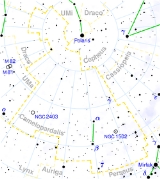
31 Camelopardalis
Encyclopedia
31 Camelopardalis is an eclipsing spectroscopic binary in the constellation
Camelopardalis
. It is approximately 405 light years
from Earth.
The binary system is classified as a white A-type
main sequence
dwarf with a mean apparent magnitude
of +5.20. Both component stars are detached main sequence stars which do not fill their Roche lobe
s. Because the components regularly eclipse each other, 31 Camelopardalis is classified as a variable star
and its brightness varies from magnitude +5.12 to +5.29 with a period of 2.93 days, which is the orbital period of the binary.
Constellation
In modern astronomy, a constellation is an internationally defined area of the celestial sphere. These areas are grouped around asterisms, patterns formed by prominent stars within apparent proximity to one another on Earth's night sky....
Camelopardalis
Camelopardalis
Camelopardalis is a large but faint constellation in the northern sky. The constellation was introduced in 1612 by Petrus Plancius. Some older astronomy books give an alternative spelling of the name, Camelopardus.-Etymology:...
. It is approximately 405 light years
Light Years
Light Years is the seventh studio album by Australian recording artist Kylie Minogue. It was released on 25 September 2000 by Parlophone and Mushroom Records. The album's style was indicative of her return to "mainstream pop dance tunes"....
from Earth.
The binary system is classified as a white A-type
Stellar classification
In astronomy, stellar classification is a classification of stars based on their spectral characteristics. The spectral class of a star is a designated class of a star describing the ionization of its chromosphere, what atomic excitations are most prominent in the light, giving an objective measure...
main sequence
Main sequence
The main sequence is a continuous and distinctive band of stars that appears on plots of stellar color versus brightness. These color-magnitude plots are known as Hertzsprung–Russell diagrams after their co-developers, Ejnar Hertzsprung and Henry Norris Russell...
dwarf with a mean apparent magnitude
Apparent magnitude
The apparent magnitude of a celestial body is a measure of its brightness as seen by an observer on Earth, adjusted to the value it would have in the absence of the atmosphere...
of +5.20. Both component stars are detached main sequence stars which do not fill their Roche lobe
Roche lobe
The Roche lobe is the region of space around a star in a binary system within which orbiting material is gravitationally bound to that star. If the star expands past its Roche lobe, then the material can escape the gravitational pull of the star. If the star is in a binary system then the material...
s. Because the components regularly eclipse each other, 31 Camelopardalis is classified as a variable star
Variable star
A star is classified as variable if its apparent magnitude as seen from Earth changes over time, whether the changes are due to variations in the star's actual luminosity, or to variations in the amount of the star's light that is blocked from reaching Earth...
and its brightness varies from magnitude +5.12 to +5.29 with a period of 2.93 days, which is the orbital period of the binary.

